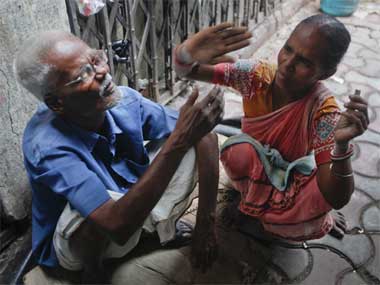The poverty estimates generated from National Sample Survey (NSS) data for 2009-10 show no clear pattern or trend on why poverty falls (or does not fall) in various states.
The overall numbers show the following broad conclusions:
Between 2004-05 and 2009-10 - which is roughly coterminous with UPA-1 - the number of people below the poverty line, as estimated from household consumer expenditure surveys, shows a dramatic fall of 7.4 percent to under 30 percent of the total population.
[caption id=“attachment_250255” align=“alignleft” width=“380” caption=“Beyond the correlation to NREGA, the latest NSS jobs data show no particular pattern. Reuters”]  [/caption]
This means, during the five-year period around 52.5 million people were pulled above the poverty line, but this still leaves around 354.7 million below it.
The only direct correlation between the reduction in poverty and official action to remove it seems to be the Mahatma Gandhi National Rural Employment Guarantee Act (NREGA) which promises 100 days of guaranteed work or wages to at least one person per household in rural areas.
In the year 2009-10, NREGA provided 52.53 million households with employment - and this number in uncannily close to the 52.5 million people pulled out of poverty during the five-year period from pre-NREGA 2004-05 to post-NREGA 2009-10.
To be sure, the NREGA scheme operates only in rural areas - but these numbers too show great correlation. In rural areas, 47.6 million people were lifted above the poverty line. Since urban workers tend to migrate back to rural areas when NREGA work is available, the data clearly show the same thing.
Another NREGA link is the slower reduction in urban poverty levels - which fell from 25.5 percent in 2004-05 to 20.9 percent five years later. Rural poverty fell faster from 42 percent to 33.8 percent during the five-year period.
So, what are the implications?
Since it is obvious that NREGA has had a huge impact on rural wages, livelihood and poverty, the important thing is to streamline it to prevent corruption and leakage. One also has to ensure that the enormous spends on NREGA are used to create real assets.
The danger is that NREGA may be creating dependence on state-led spending, even while shifting people from regular (but genuine) employment to make-work schemes. This brand of welfarism may have implications for overall employment growth in the rest of the rural economy.
An overall view on whether NREGA has done more good than bad would need a comparison of 1999-00 NSS data on poverty with the 2004-05 and 2009-10 data based on the Suresh Tendulkar way of estimating poverty.
The Tendulkar Committee, says a Planning Commission note, developed a methodology using implicit prices for estimating state-wise poverty lines for the year 2004-05. Using these poverty lines and distribution of monthly per capita consumption expenditure, the committee estimated poverty ratios. The latest poverty data have been calculated using the same method.
As _Firstpost_ pointed out before, extrapolations by rating agency Crisil using NSS jobs data for 2004-05 and 2009-10 show that in this five-year period only 2.2 million jobs were created, while in the previous five-year period, 92.7 million were created.
It is only by mapping the poverty data change between 1999-00 and 2004-05 and the one we now have (indicating a 7.4 percent drop in poverty between 2004-05 and 2009-10) will we know how much difference a job creation scheme has helped in reducing poverty.
Beyond the correlation to NREGA, the latest NSS jobs data show no particular pattern: if we were to put all states in five major buckets - those registering poverty rate reductions of over 15 percent between 2004-05 and 2009-10, those in the 10-15 percent range, those in the 5-10 percent range, those in the 0-5 percent range and those in negative territory - the conclusions are mixed.
The outlier states - those who reduced poverty by more than 15 percent over five years - are just four: Orissa, Sikkim, Tripura and Goa. Orissa has clearly benefited by having a single-party stable government. Perhaps, Sikkim too. Tripura has had a Left government for long, and Goa has had an unstable one marked by illegal mining scandals.
The next (10-15 percent) bucket has a mix of usual suspects and unexpected performers: Maharashtra and Tamil Nadu constitute the former, but Himachal, Uttarakhand and Madhya Pradesh constitute the latter.
The moderate poverty removers - those congregating on either side of the national average of 7.4 percent - include Andhra Pradesh, Gujarat, Rajasthan, Karnataka, Kerala and West Bengal, among eight states.
The underperformers (0-5 percent) include Bihar, Uttar Pradesh, Haryana (surprising), Punjab, and Chhattisgarh. Maybe the Nitish Kumar hype is overdone, and Mayawati and Raman Singh didn’t quite manage any miracle. In fact, Bihar is one of the few states to actually see an increase in the absolute numbers below the poverty line - from 49 million to 54 million.
Planning Commission member Abhijit Sen says the bad performance can be associated with states with poor public distribution and NREGA performance. He says: “Bihar, Uttar Pradesh and the North East, where again poverty has increased, are the places where there is no PDS reform. And the NREGA in this area didn’t do well” ( See interview ).
The negative performers are mostly in the north-east, indicating that insurgency and immigration from Bangladesh may be hampering their poverty reduction impulses.


)
)
)
)
)
)
)
)
)



